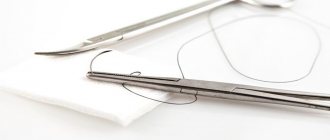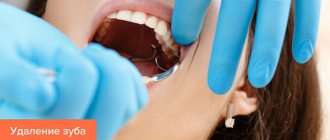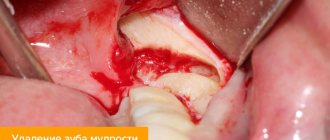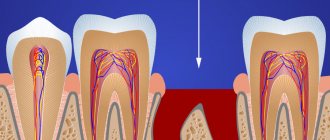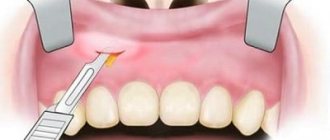Content:
- Why is the wound sutured after pulling out the figure eight?
- Classification of seams
- How long do you need to walk with non-absorbable sutures?
- How long does it take for self-absorbable sutures to dissolve?
- What complications can you encounter after suturing?
- Recommendations for patients
A dental surgeon applies sutures after removing a wisdom tooth if the intervention was very complex and serious injury to the gums occurred.
Often, specialists insist on suturing a wound, even if it is small, in order to minimize the likelihood of infection. Let's consider what material doctors use when suturing after tooth extraction, whether it needs to be removed in the future, and how to properly care for the injured area.
Pain after suturing the hole: pathology and norm
Pain in the suture area is normal. Injury to the gums due to major surgery causes pain, especially in the first days.
The patient must understand that tooth extraction means damage to the ligaments that hold the tooth in the gum, rupture of nerve fibers and blood vessels. During the operation, the pain is blocked by the anesthetic, but after the anesthesia wears off, discomfort is observed at the site of the sutures.
The following sensations should not cause concern:
- aching pain for the first 24 hours after removal;
- slight swelling of the tissues in the surgical area
- discomfort and slight pain when opening the mouth;
- short-term increase in body temperature.
In rare cases, after a complex removal, the patient may experience chills, facial swelling, purulent discharge, cough, and nausea. These signs should not be ignored - it is better to immediately seek help from a specialist.
Why is the wound sutured after pulling out the figure eight?
Wisdom teeth are very insidious and often lead to serious problems. Pulling it out most often resembles an operation. Since the roots of the unit go deep into the gum and can be ornate, tortuous, soft tissue is often excised to extract them. After all solid debris has been removed from the depths of the tissue, the wound is sutured. This is done in order to:
- prevent bleeding;
- protect the blood clot formed in the wound from injury;
- protect the operated area from the accumulation of food debris;
- minimize the risk of damage to the operating area;
- speed up regeneration processes.
It is believed that applying sutures after wisdom tooth removal reduces the likelihood of infection by approximately 90%. This is explained by the fact that pathogens cannot penetrate into the deep layers of the wound.
Simple removal of the top eight
Simple is the removal of the upper wisdom tooth, which does not require preliminary dissection of the gums. This is how molars are removed that have erupted without pathologies and have small, even roots. Simple removal is carried out in 4 stages.
- The doctor conducts a diagnosis
- takes an X-ray or CT scan, assessing the position of the tooth and the structure of the root system. - The patient receives pain relief.
Removal of the upper “eight” is usually performed under local anesthesia. - The doctor places forceps on the crown of the tooth and performs luxation and traction
- he rocks the tooth and pulls it out of the socket. - The hole is treated with an antiseptic and, if necessary, sutured.
Read more about the operation in a separate article.
Classification of seams
After tearing out the “eight”, at the discretion of the dental surgeon, regular and self-absorbing sutures can be applied.
In the first case, we are talking about materials that cannot dissolve on their own. These are silk, nylon, polyester. Such threads are not absorbed. They securely hold the edges of the wound until the doctor removes them. Self-absorbable material is absorbable. Its main advantage is that the patient does not have to visit the doctor again to have his stitches removed. The latter disappear without a trace on their own.
There are two types of self-absorbable threads:
- Absorbable due to hydrolysis reaction. These include Dexon and Vicryl threads. They are synthetic and do not cause allergic reactions. The edges of the wound are securely held for about one month.
- Absorbable due to the influence of enzymes. We are talking about Catgut. Its particles are quickly eliminated from the human body. Catgut is used for complex dental operations. But it is important to consider that it contains foreign proteins that can cause inflammation.
There is no need to think that suture materials dissolve without a trace. They simply break down into tiny particles that a person spits out or swallows. These particles are non-toxic and therefore cannot cause poisoning.
How long do you need to walk with non-absorbable sutures?
If the doctor used non-absorbable suture material after removing a wisdom tooth, then seven to ten days later the patient must return for an appointment. The doctor will evaluate how the wound is healing and determine whether the suture material can be removed.
There is no need to be afraid of this procedure. It causes only minor discomfort. The dentist cuts the stitches one by one and, grasping one end of the thread with tweezers, carefully pulls it out. If the patient is afraid of pain, the doctor may use topical anesthesia.
Antibiotics and other drugs after wisdom tooth removal
Antibacterial drugs are prescribed only in cases where there has been an infection in the oral cavity or after an intervention there is a high risk of infection.
You can numb a wisdom tooth after removal with regular painkillers, such as ibuprofen. But don't rush to take the pill. Sometimes an ice pack helps relieve pain. If you still cannot do without medication, you can start with half a tablet.
If, even after taking the full dose indicated in the annotation, the pain does not go away for a long time and increases, you should consult a doctor: perhaps he will prescribe stronger drugs.
How long does it take for self-absorbable sutures to dissolve?
Typically, the suture material disintegrates after three weeks. The patient may notice how it has fallen out, or simply find that the wound remains clean, without threads. In more detail, catgut dissolves from ten to fourteen days, Vicryl - within thirty days, Dexon - a little longer.
It is impossible to name the exact period of resorption. Here everything depends not only on the characteristics of the material used, but also on the individual characteristics of the patient’s body. It also happens that the threads are still in place, but the doctor no longer sees the need for them. Then he removes them in the same way as non-absorbable ones.
Anesthesia (pain relief)
To minimize discomfort during an injection, you need to treat the injection site with a special anesthetic gel. This is the so-called topical anesthesia. It is very often used in pediatric dentistry, but we also use it in working with adults. As practice shows, there are fewer unpleasant sensations, and the taste is pleasant... at least some kind of joy.
When removing teeth from the upper jaw, as a rule, a simple infiltration of anesthetic into the area of the tooth being removed is sufficient. It is carried out using a special syringe with specially selected anesthetics and is called infiltration .
When removing teeth on the lower jaw, infiltration anesthesia is usually not enough (with the exception of the frontal group of teeth, from canine to canine). Therefore, the anesthesia technique changes somewhat - the anesthetic, using a long but very thin needle, is applied directly to the nerve bundle responsible for the innervation of the desired areas. This anesthesia allows you to “turn off” sensitivity not only in the area of the tooth being removed, but also in the lip, chin, part of the tongue, etc.
It should be noted that during and immediately after anesthesia, a number of interesting phenomena may be observed - increased heart rate, trembling of limbs, an inexplicable feeling of anxiety. Many patients begin to panic about this. But there is no need to panic! These are side effects of most modern anesthetics and go away on their own within 10-15 minutes.
Well, the anesthesia is done! Now you need to make sure that it was carried out successfully?
Those places that should ideally be numb are listed above. Also, using a special instrument and pressing on the gum in the area of the operated tooth, we determine whether the pain still remains or no longer exists. The only thing that should be felt is the sensation of “something” touching the gum. That is, tactile sensations are still preserved, but pain is no longer present.
And then our actions differ depending on what type of wisdom tooth we are dealing with.
What complications can you encounter after suturing?
- As a rule, the regeneration process proceeds without complications. But it happens that the patient encounters symptoms that bother him. Let's name the most common complications after wisdom tooth removal:
- Bleeding. In the first three days after surgery, periodic bleeding is considered normal, but if bleeding persists longer, you should immediately consult a dental surgeon.
- Three days after removal, the gums look very swollen and very painful. You need to make sure that all roots have been removed. To do this, pictures of the inflamed area are taken.
- Increased temperature several days after surgery. If the hole bleeds, is swollen and hurts, and the body temperature is elevated, we can talk about inflammation of the surgical area. To remove it, you need to carry out antibiotic therapy.
If you have the slightest doubt regarding the healing process, you should immediately see a qualified dentist. Very often, delay makes the situation worse. It is better to get a consultation once again than to treat an advanced complication for a long time.
When and how is the procedure for removing sutures in dentistry performed?
The time for suture removal is determined by the dentist, guided by the process of regeneration (healing) of the soft tissues of the mucous membrane, which depends on:
- on the age of the patient;
- complications of surgical intervention;
- presence of complications.
Usually, sutures are removed 5-10 days after they are applied.
The dentist removes sutures as follows:
- the surface of the wound is disinfected with an antiseptic;
- if the patient has a low pain threshold, local anesthetics are used (but usually this is not necessary);
- Using surgical scissors and anatomical tweezers, the dentist carefully cuts and removes the threads from the healed wound;
- a visual examination is carried out to check the integrity of the wound;
- Disinfection of the suture prevents the risk of wound inflammation.
Sometimes sutures are removed due to the risk of suppuration in the area of the operation. In this case, the sutures are removed, sanitizing procedures are performed and appropriate antimicrobial therapy is prescribed.
Recommendations for patients
To ensure that the recovery process takes little time and goes without complications, it is recommended:
- Follow all doctor's orders.
- Do not eat anything for the first few hours after surgery. In the first two to three days after therapy, chew food with the healthy side of the jaw and give preference to soft foods.
- Do not touch the unhealed hole with your hands.
- Do not try to remove a blood clot with your tongue or foreign objects.
- Rinse only if prescribed by a doctor.
- Avoid strenuous physical activity for the first two weeks.
- Do not attempt to remove stitches yourself.
By following these simple rules, a person can quickly return to their normal lifestyle after dental surgery.
